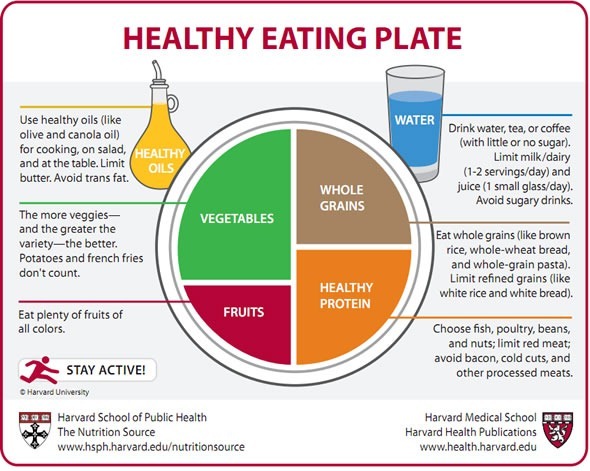A few months earlier the United States Department of Agriculture unveiled ‘MyPlate’, the replacement for the food pyramid. Now the Harvard School of Public Health says that MyPlate doesn't offer enough about good nutrition, and they have offered their own version.
Harvard unveiled its modified version of the USDA plate, called the Healthy Eating Plate in Wednesday September 14th. Walter Willett, professor of epidemiology and nutrition at Harvard, says it addresses the shortcomings of MyPlate. “The main thing is that MyPlate isn't specific enough to really give enough guidance,” Willett said.
In the article, the editors of Harvard Health Publications state, “[The Harvard Healthy Eating Plate] offers more specific and more accurate recommendations for following a healthy diet than MyPlate, developed by the U.S. Department of Agriculture and the Department of Health and Human Service.” “In addition,” they say, “the Healthy Eating Plate is based on the most up-to-date nutrition research, and it is not influenced by the food industry or agriculture policy.” In a press release issued on September 14, the Harvard School of Public Health said that the Harvard Healthy Eating Plate “addresses important deficiencies in the [USDA] MyPlate icon.”

MyPlate is a USDA resource that offers nutrition recommendations. It's symbolized by a plate with four sections - fruits, vegetables, grains and proteins - with an attached glass of milk that the agency says should all be part of a healthy, balanced diet.
Harvard's plate also has the same four sections but with more detailed information on what foods to eat, and which ones to avoid. For example, in place of the grains section, Harvard's includes a whole grains section. Willett said, “There's a distinction between any old grains and whole grains.” Eating too many refined grains, such as white bread and white rice, can increase the risk of heart disease and type 2 diabetes, he said.
Other differences include an explanation of what proteins are healthy - poultry, fish, beans and nuts - emphasizing the need for healthy fats, such as olive and canola oils and explaining that potatoes aren't a healthy vegetable choice. Harvard's plate also replaces milk with water and recommends only one to two servings a day of low-fat milk. “Modest dairy consumption is OK, but having a glass of milk with every meal is excessive and does not reduce the risk of osteoporosis and fractures,” Willett explained.
The USDA has not yet responded to a request for comment.
When the USDA unveiled its plate in June, nutrition experts praised it for its simplicity and for emphasizing the importance of key food groups, such as fruits and vegetables. Nutritionists support Harvard's changes, saying the alternative plate offers more specific information about what to eat and what to avoid and also makes healthy recommendations.
“The Harvard plate ... is detailed in its recommendations, differentiating among foods in a given category and more importantly, it is explicit about foods not to eat,” said Dr. David Katz, founding director of the Yale University Prevention Research Center.
“This would be the type of diet that would reduce obesity, hypertension, type 2 diabetes, dyslipidemia [an abnormal level of fats and/or cholesterol in the blood] and cardiovascular diseases,” said Dr. Carl Lavie, a cardiologist at Ochsner Medical Center in New Orleans, although he said he doesn't see the harm in additional servings of low-fat milk.
“I believe whole grains and fiber are very important to cardiovascular and gastrointestinal health,” said Paul Ehrmann, founder and medical director of Family Health Care Center in Royal Oak, Mich. “It's also beneficial with weight management.”
“People struggle to make changes, so simple steps make changes seem less daunting,” said Connie Diekman, director of university nutrition at Washington University in St. Louis. “Healthy eating is about proper food choices and portions, along with enjoyment - not fear or avoidance.”
“Perhaps we should aim to show a breakfast plate, lunch plate, snack plate or in some cases, a bowl to illustrate the concept, i.e., a turkey wrap with roasted veggies and an apple embraces the plate, but in one item,” said Leslie Bonci, director of sports nutrition at the University of Pittsburgh Medical Center. She believes visual elements are more effective.
“Not everyone needs whole grains with every meal,” said Molly Kimball, sports and lifestyle nutritionist at Elmwood Fitness Center in New Orleans. “If they get plenty of fiber-rich veggies and they have the carbs from fresh fruit and/or low-fat dairy, they may not need to double up on the carbs/calories of a whole grain starch.” “Milk and dairy should not be limited for children, women and for the elderly. Low fat types of dairy should instead be chosen,” said Carla Wolper, assistant professor of eating disorders research at Columbia University.
But Willett believes the Healthy Eating Plate will ultimately lead people to make better choices. “There is a huge amount of data to support the benefits of healthy food choices, and they make a very, very big difference in people's health,” he said.